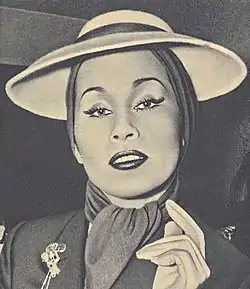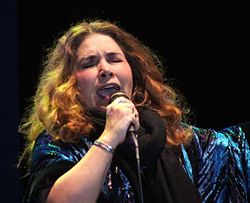Music of Peru
The Music of Peru is an amalgamation of sounds and styles drawing on Peru's Andean, Spanish, and African roots. Andean influences can perhaps be best heard in wind instruments and the shape of the melodies, while the African influences can be heard in the rhythm and percussion instruments, and European influences can be heard in the harmonies and stringed instruments. Pre-Columbian Andean music was played on drums and string instruments, like the European pipe and tabor tradition. Andean tritonic and pentatonic scales were elaborated during the colonial period into hexatonic, and in some cases, diatonic scales.
| This article is part of a series on the |
| Culture of Peru |
|---|
 |
|
Peru portal |
History

The earliest printed polyphonic music in Peru, indeed anywhere in the Americas, was "Hanacpachap cussicuinin," composed or collected by Juan Pérez Bocanegra and printed in 1631.[1]
Instruments
Stringed instruments
Peruvian music is dominated by the national instrument, the charango. The charango is member of the lute family of instruments and was invented during the Viceroyalty of Peru by musicians imitating the Spanish vihuela. In the Canas and Titicaca regions, the charango is used in courtship rituals, symbolically invoking mermaids with the instrument to lure the woman to the male performers. Until the 1960s, the charango was denigrated as an instrument of the rural poor. After the revolution in 1959, which built upon the Indigenismo movement (1910–1940), the charango was popularized among other performers. Variants include the walaycho, chillador, chinlili, and the larger and lower-tuned charangon.
While the Spanish guitar is widely played, so too is the Spanish-in-origin bandurria. Unlike the guitar, it has been transformed by Peruvian players over the years, changing from a 12-string, 6-course instrument to one having 12 to 16 strings in a mere 4 courses. Violins and harps, also of European origin, are also played.
Percussion instruments
The cajón is an important percussion instrument developed by African slaves. People imply the cowbell may also be of African origin. While the rhythms played on them are often African-influenced, some percussive instruments are of non-African origin. For example, of European origin is the bombo, and of Andean origin are the wankara and tinya respectively.
Wind instruments
In addition to the ocarina and waqra phuku, there are Peruvian wind instruments of two basic types, panpipes and flutes, both of Native Andean origin and built to play tritonic, pentatonic and hexatonic scales, though some contemporary musicians play instruments designed to play European diatonic scales. Of the former variety, there are the siku (or zampoña) and antara. Of the latter variety, there are the pinkillu, tarka, and quena (qina) flutes.
Dances
See Peruvian dances
- Apiliarg—A dance from the Oporeza area.
- Carnaval en Amazonas—A dance from the Amazonas region similar to the huayno.
- Carnavalito—A dance from southern Peru and the Bolivian Altiplano similar to the huayno.
- Chumaichada—A dance from the Amazonas region with strong Native Peruvian musical influences and strong European dance influences.
- Creole Waltz—A Peruvian adaptation of the European waltz.
- Cueca—A pan-Andean compound 3/4-6/8 dance rhythm.
- Cumbia—A Colombian-in-origin 2/4 dance rhythm.
- Danza de tijeras—A dance from southern Peru.
- Danzantes de Levanto—A dance from the Amazonas region.
- Diablada—A 2/4 dance rhythm from southern Peru, Bolivia, and northern Chile.
- Morenada—A dance rhythm from southern Peru and western Bolivia.
- Festejo—A popular 12/8 Afro-Peruvian dance form.
- Harawi (genre) or Yaravi—A highland dance danced to various meters: 2/4, 3/4, and 4/4.
- Huanca (dance)—A dance from the Amazonas region.
- Huayño—A popular 2/4 highlands dance.
- Kantu—A highland circle dance.
- Landó—An Afro-Peruvian compound 3/4-12/8 dance rhythm.
- Marinera—An Afro-Peruvian 6/8 dance rhythm.
- Polka—A 2/4 European-in-origin dance form.
- Sikuri—A dance rhythm from southern Peru and western Bolivia.
- Son de los Diablos
- Tondero—A northwestern Peruvian 6/8 dance form.
- Zamacueca—A 6/8 Afro-Peruvian dance form.
Notable performers

Manuelcha Prado (born 10 June 1955) is a guitarist, singer, composer, compiler and troubadour of Andean music. He is also known for many people as "The Saqra of the Guitar".
Jaime Guardia (born 10 February 1933) is a Peruvian singer and charango player. He has performed and recorded as a solo act and with the group Lira Paucina.
Raul Romero's recordings of saxophone and clarinet ensembles from the Mantaro Valley have proved extremely influential.
Susana Baca (born 24 May 1944) is a prominent Peruvian singer-songwriter and two-times Latin Grammy Award winner.
One important space for Peruvian contemporary classical music is Circomper, the Peruvian Composition Circle.
See also
Notes
- Kerman, Joseph; Tomlinson, Gary; Kerman, Vivian (2007). Listen (6th ed.). Boston: Bed-St. Martin's. p. 94. ISBN 0-312-43419-7. Retrieved 27 July 2014.
External links
| Wikimedia Commons has media related to Music of Peru. |
- Música Criolla del Perú
- (in French) Audio clips: Traditional music of Peru. Musée d'ethnographie de Genève. Accessed November 25, 2010.
- Brill, Mark. Music of Latin America and the Caribbean, 2nd Edition, 2018. Taylor & Francis ISBN 1138053562
- BBC Radio 3 Audio (60 minutes): Huaynos of the Andes and Afro-Peruvian music. Accessed November 25, 2010.
- BBC Radio 3 Audio (60 minutes): The music of Ayacucho. Accessed November 25, 2010.
- BBC Radio 3 Audio (60 minutes): Iquitos, Huancayo and Lake Titicaca. Accessed November 25, 2010.
- Manuelcha Prado Official website
- Music from the Andes and Nearby Regions
- Going Underground: Peru An exploration into the underground music scene in Peru
1